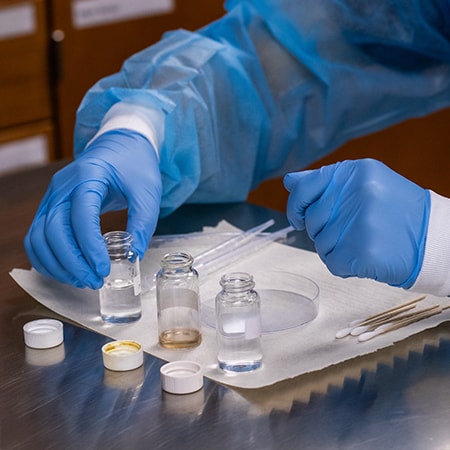The UAB Master of Science in Forensic Science program is one of fewer than 30 Master of Science in Forensic Science programs in the U.S. accredited by FEPAC, the Forensic Science Education Programs Accreditation Commission. Our program prepares students for careers in various forensic science and conventional analytical laboratories, emphasizing the application of scientific methods and technologies to legal proceedings. It may also be used to build a strong foundation for doctoral and professional studies and offers the opportunity for students to pursue a Graduate Certificate in Computer Forensics that involves additional, elective coursework.
Congratulations to the classes of 2022-2024. During this time 30 students completed the program. Of these, 22 (73%) are working in a laboratory. Eighteen of the graduates are employed in municipal or state forensic science laboratories, one in a computer forensic laboratory, three are employed in commercial laboratories, and two are in PhD programs. Of the remaining graduates, one graduate was working in a different field and five were not employed or did not respond to the post-graduate survey. The students in the graduating classes of 2022-24 also participated in internships at the Alabama Department of Forensic Sciences, the UAB Core Toxicology Laboratory, and Labcorp.
According to the National Institute of Justice, students wishing to pursue a career in forensic science should be aware that positions in these fields usually require extensive background checks similar to those required for law enforcement personnel, and are likely a condition of employment.
Research Papers
-
2024
- Analysis of Burned Fabrics Using Fourier Transform Infrared Spectroscopy
- Development of a Direct Application Workflow for UAB’s Custom Three STR Multiplex
- Technique/Chemical Comparisons of Submerged Fingerprints
- Prevalence and Analysis of Xylazine in Postmortem Casework in Jefferson County, Alabama
- Stability of Fentanyl in Toxicology Samples Selected from a Study of Mortality amongst the Homeless Population in Jefferson County
- Comparative Analysis of Cannabinoid Metabolites in Urine Using Gas Chromatography-Mass Spectrometry
- Qualitative Analysis of Pharmaceutical and Illicit Drugs in Wastewater Using Gas Chromatography-Mass Spectrometry
-
2023
- DNA Analysis of Soil-Contaminated Blood in the Presence of Naturally Occurring PCR Inhibitors
- The Validation of a Qualitative DPX and GC-MS Method of Testing For THC-COOH in Urine
- A Target Fiber Analysis of Red Acrylic on Movie Theater Seats
- Locating and Photographing Biological Stains Using Inexpensive Light Sources
- Identification Through the Human Skin Microbiome After Primary Transfer and Handwashing
- Analysis of Drugs in Alcoholic Beverage Residue Related to Drug Facilitated Sexual Assault
- A Comparison of a Direct Lysis Method with a Silica Spin Column Method for DNA Extraction from Blood
- Comparing DNA Collection Methods and Locations for Face Masks
-
2022
- Identification of TIANAA Supplement Ingredients & Tianeptine Pyrolysis Products using Gas Chromatography
- Exploring New Methods for Extracting DNA from large pieces of fabric
- The Effect of Multiple Washes and Thread Count on Semen-Stained Sheets
- Determining Extended PMI of Fetal Pigs Buried In Fayetteville, TN in June 2021 Based on ATR-FTIR Blood Analysis
- Using DNA Recovered from Secondary Transfer to Link Perpetrators to Violent Crime
Theses
-
2024
- Identfication of the Synthetic Cannabinoids BZO-POXIZID And MDA-19 Using Gas Chromatography- Mass Spectrometry
- The Effect of The Chemical and Physical Properties of Coton on The Retention of Spermatozoa
- Fentanyl Overdoses and Use of Randox MultiSTAT for Investigative Purposes.
-
2023
- Validation of ‘Bath Salts’ Using Gas Chromatography-Mass Spectrometry
- Analyzing Cannabinoid Stability in Different Conditions And Validating Novel Cannabinoids for Oral Fluid Analysis
- Use of ATR-FTIR Spectroscopy for Estimating Postmortem Interval, Age of Bloodstains, Sex of Blood Donor, And Species Differentiation
- Development and Validation of a Multiplex STR Amplification Reaction for Academic and Research Purposes
-
2022
- Evaluating Cannabinoid Interference and Drug Stability in Oral Fluid for DUID Testing
- The Validation of a Qualitative Analytical Method to Detect Nine Cannabinoids for Forensic Drug Analysis Using Gas Chromatography/Mass Spectrometry
- Method Development of Drug Court Samples
The program support includes many UAB faculty members from other departments, personnel from the Alabama Department of Forensic Sciences' Birmingham laboratory, the Jefferson County Medical Examiner's Office, and local forensic science-related private institutions. In addition, the program maintains a close working relationship with the DNA profiling laboratories of the Alabama Department of Forensic Sciences and hosts the editorial offices of the Forensic Science Review (the only review journal in forensic science). Faculty research and practice focus especially on forensic aspects of drug chemistry and DNA-based identification.
For more information contact the Director of Graduate Studies in Forensic Science, Jason Linville.


